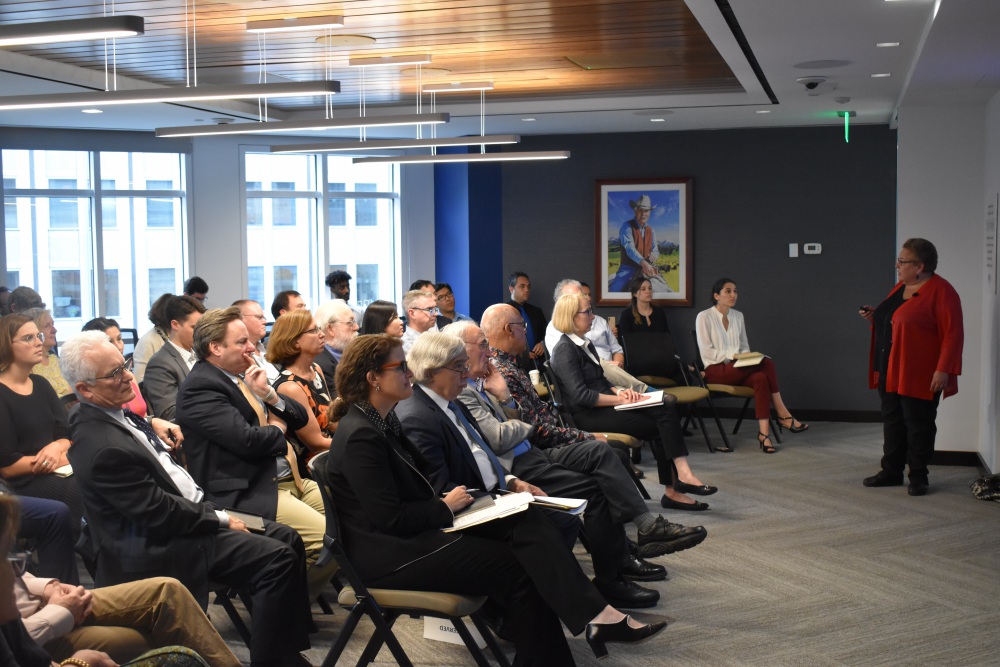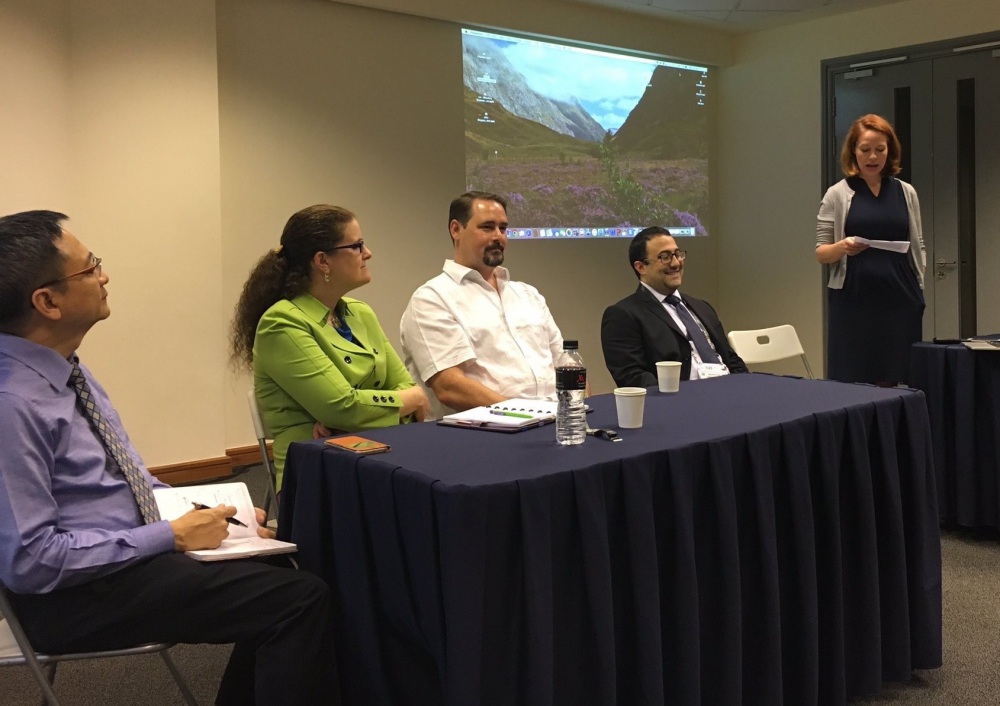
Get to Know NTI: Aparupa Sengupta
Aparupa Sengupta, senior program officer for NTI’s Global Biological Policy and Programs team (NTI | bio), sat down with NTI’s Mary Fulham for the latest in Atomic Pulse’s “Get to Know NTI” series.
Atomic Pulse
This post was written by Avery League, an intern
with NTI’s Global Biological Policy and Programs team. League will graduate in
2020 from the School of Foreign Service at Georgetown University with a major
in Science and Technology in International Affairs and a French minor.
In November 2018, Chinese biophysicist He Jiankui shocked the world
with an announcement of the birth of the first gene-edited babies. The declaration
was met with skepticism and outrage, and the scientific community expressed concern
over Dr. He’s neglect of fundamental technical and ethical precautions during
his experiment. In the wake of Dr. He’s claims that these babies had undergone
germline gene-editing, which changes heritable traits that can be passed from
parent to child, the World Health Organization (WHO) convened an Expert Advisory Committee on Developing Global Standards
for Governance and Oversight of Human Genome Editing, co-chaired by NTI Board Member Dr. Margaret A. Hamburg.
In July, the Nuclear Threat Initiative (NTI)
hosted a member of that new WHO committee, bioethicist and NTI | bio Advisory
Group member Professor
Alta Charo, for a presentation on the benefits, risks,
and governance of genome editing as part of the NTI Seminar Series. Although genome
editing is an important scientific advance that can contribute to a future that is more resilient to
disease, food insecurity, and environmental instability, it also has the
potential to enable the creation of biological weapons.
Understanding Genome Editing Technologies
Genome editing technologies, such as CRISPR, a
tool that enables precisely targeted cuts and changes to DNA, have immense
potential to revolutionize the treatment of genetic diseases and could offer
new avenues for treatment — and perhaps multi-generational prevention — of medical conditions like muscular dystrophy and cystic
fibrosis. At the same time, genome editing
technologies could pose risks to patients when used without the proper
precautions. In the case of Dr. He’s research, he used CRISPR to conduct
germline editing, which is not only too early in technical development to be
safe and effective, but also controversial because its consequences are not
limited to the people seeking the intervention, but can extend to their
children, children’s children and all subsequent generations. Somatic genome editing,
which results in changes in DNA that are not heritable, is a less controversial
area of genome editing for clinical needs because it mitigates the risk that
unintended changes will be passed to future generations.
In addition to ethical concerns, genome editing
is accompanied by other practical risks that should be considered and mitigated.
It can be used in the creation and modification of dangerous pathogens and could
be used to insert elements of a gene drive that artificially propagate specific
genes to an organism’s offspring. Professor Charo noted that gene drives are
being explored in mosquitos as a method to fight malaria through the spread of
genes that make mosquitoes resistant to the malaria parasite. However, Professor
Charo also expressed concerns that gene drives could also be misused – for
example, by propagating genes that could impair plant reproduction and reduce the
global food supply. The gene drive example is a classic example of the dual-use
dilemma that surrounds genome editing and technological advances in general.
Oversight and Regulation of Genome Editing
During her seminar, Professor Charo discussed
the benefits of a “yellow light” strategy of oversight for genome editing, an
idea she outlines in a paper published in Science
in 2015. As a practical approach to risk
mitigation, she explained that a “yellow light” strategy would allow germline
genome editing to advance with conditional approval but would not permit the
research to continue if certain requirements are not met and the desired
results are not achieved. This approach differs from a “green light” approach
to regulation, which would allow all research to be conducted until a specific
problem arises but would do little to prevent unsafe practices. On the other
hand, “red light” oversight would not allow germline genome editing to be
conducted until it is explicitly permitted on a case-by-case basis. A global moratorium on germline genome
editing, which has been called for by a number of prominent scientists, including Francis Collins, the director of the U.S.
National Institutes of Health, would be an example of
a “red light” strategy. However, a complete moratorium would be a challenge to
implement because there are no international enforcement mechanisms in place to
compel countries to adopt such a measure. Along these lines, a National Academy
of Sciences/National Academy of Medicine committee co-chaired by MIT’s Richard
Hynes and Professor Charo released a report in 2017 that called for
more research on the risks of germline genome editing and further development
of rigorous oversight mechanisms before allowing it to be introduced into
clinical trials, but also did not call for a complete moratorium. Professor
Charo also noted that a “yellow light” approach has been used in the regulation
of stem cell research in Japan. In the United
States, Professor Charo argued that professional self-regulation has led to
more effective government oversight of recombinant DNA work in general and stem
cell research in particular, and that it could serve as a guide for the
regulation of genome editing.
At the same time, Professor Charo emphasized that
the regulation of genome editing is an immense challenge and is not a
responsibility that can or should be left to governments alone, given that
scientific advances are outpacing the ability of governments to oversee them. Instead,
she suggested that journal editors, insurers, patent holders, funders, and
other researchers take a more active role in creating new approaches for
governance. NTI has argued that such catalytic non-governmental approaches
could include financial incentives for biotechnology investors to improve
biosecurity, the establishment of a seal of approval for research institutions
that adopt biosecurity norms, and insurance incentives for reducing biological
risks, many of which are now being considered within the NTI Biosecurity Innovation and Risk Reduction Initiative. Additionally, Professor Charo stressed the
importance of considering global cultural differences and the impact that cultural
variations might have on attitudes towards germline genome editing. These
differences make it even more important that a common understanding of responsible
genome editing is reached on a global level because advances in this field
anywhere could impact people everywhere.
The risks posed by genome editing should not
be underestimated or ignored. However, genome editing must also be appreciated
as a meaningful scientific breakthrough with the potential to improve the well-being
of people around the world. That is why it is vital for a variety of
stakeholders—including governments, technical leaders, investors, funders, and
publishers—to prioritize biosecurity in current and future biotechnology
research. Within NTI’s Biosecurity Innovation and Risk Reduction Initiative,
global leaders are piloting several projects to do just that, including:
improving DNA synthesis screening, incentivizing adherence to biosecurity norms
within research institutions, and improving biosecurity risk assessment for
biotechnology research funders and investors. Working with international
partners committed to biosecurity, this Initiative aims to catalyze biosecurity
safeguards and approaches that allow researchers to realize the full range of
benefits from technologies like genome editing while minimizing the potential
risk of a high-consequence biological event.
Professor Charo serves as a member of the NTI
| bio Advisory Group.
Sign up for our newsletter to get the latest on nuclear and biological threats.
Aparupa Sengupta, senior program officer for NTI’s Global Biological Policy and Programs team (NTI | bio), sat down with NTI’s Mary Fulham for the latest in Atomic Pulse’s “Get to Know NTI” series.
NTI | bio Explores Ways to Enhance Disease Surveillance Through Next Generation DNA Sequencing
Democratization of Synthetic Biology: Implications for Biosecurity and Pandemic Threats


